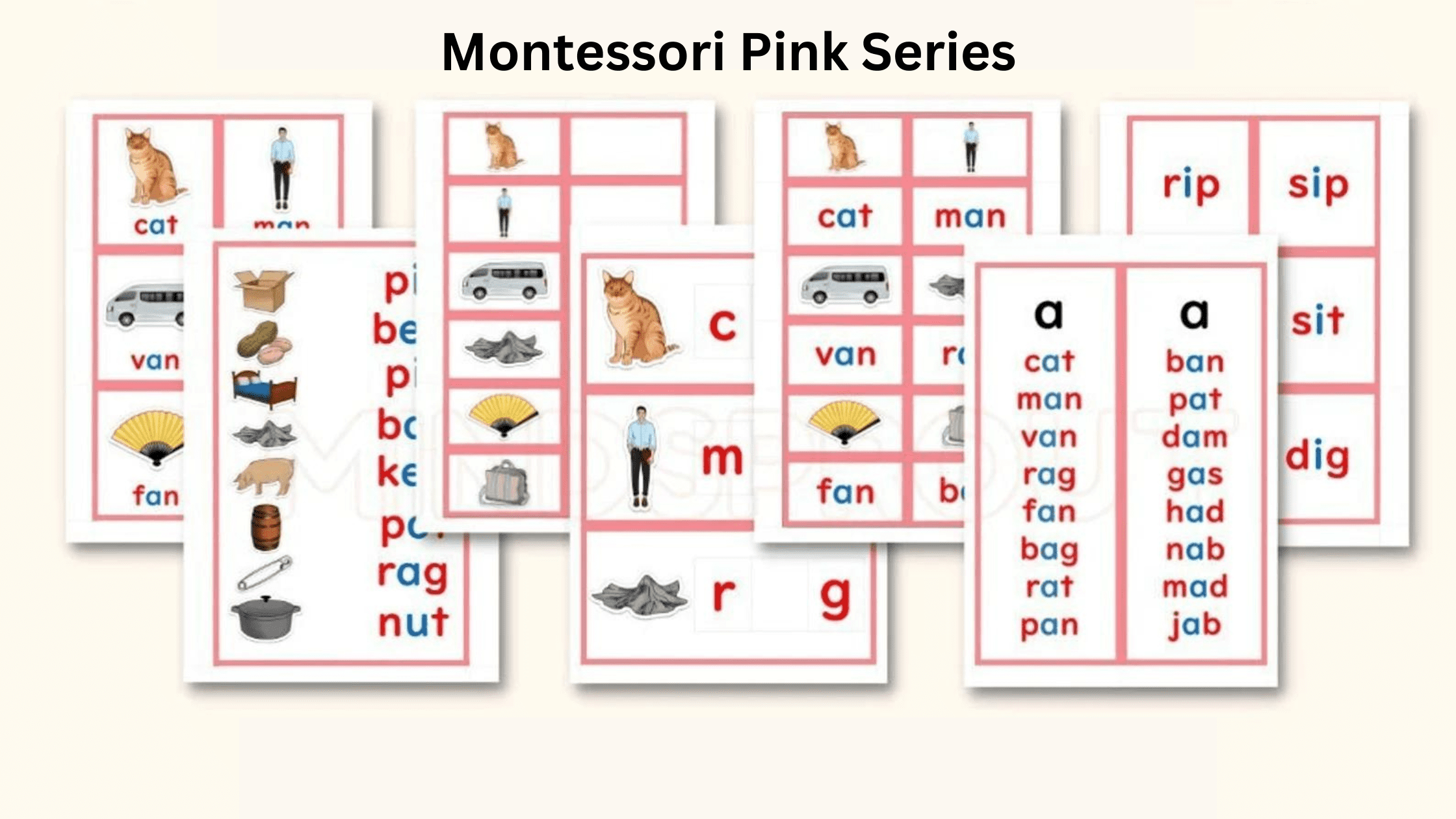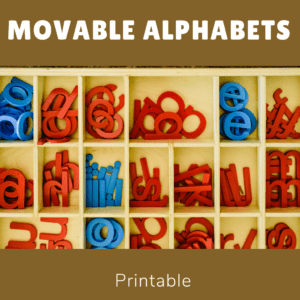The Pink series is a part of the Montessori Language Curriculum. This is used to teach letter formation and its variation to primary-level (3-6 year old) children.
The journey of reading begins with a single step. In Montessori classrooms, the language curriculum (sentence formation is divided into 3 parts: pink, green and blue series. To start their complex word-learning journey, the first step is the pink series. Once the child is through with the pink series, they are introduced to the green series followed by the blue series. Pink Series is a basic program developed to introduce young learners to the world of language through phonetic reading. Let us understand the Pink series first.
What is the Pink Series?
Imagine a world built with building blocks. The Pink Series works similarly. However, instead of blocks, it uses letters. This series focuses on simple, three-letter words with the CVC pattern (consonant-vowel-consonant). Words like “cat,” “dog,” and “sun” are all part of this Pink series learning.
Why is the Pink Series Important?
The Pink Series is very important because it lays the foundation for future reading success. Just as with any foundational skill, ensuring a strong base is vital for a child’s future success in reading. As a child sound out letters to build words, they learn to track the written word for symbol-as-sound correspondence, which leads to more complicated words and sentences.
What is the Purpose of the Pink Series?
The Pink Series in Montessori helps a child in the evolution of two of the main skills needed for reading – phonemic awareness, which is the ability to hear and play with sounds in words, and the foundation for future reading by introducing the basic connections between letters and their sounds.
- Building Words Before Reading: In Montessori education, children are encouraged to write or construct words with the Movable Alphabet before they begin to read. This approach, known as encoding before decoding, aligns with the Montessori principle of moving from the concrete to the abstract. By building words first, children gain a clearer understanding of how letters form words, setting them up for successful reading.
- Building Phonemic Awareness: This can be defined as the ability to identify and manipulate individual sounds—also referred to as phonemes—that make up a word. The Pink Series focuses on ones in which children learn to connect the sounds of each letter to build a whole word with simple CVC words. By sounding out letters and building words, they begin to understand how spoken language translates into written language.
- Laying the Foundations of Reading—Pink Series: This gives children a strong base for reading. In mastering the base CVC words, they develop a good understanding of letter sounds and how words are formed. It is then easier for them to tackle more complex words and sentences as they progress in their reading journey.
- Supporting Independent Work: We guide children through naming lessons and demonstrate tasks without unnecessary speech, then allow them to work independently. Observing from a distance, we resist the urge to correct them, even if we see mistakes. This practice helps maintain their concentration and fosters a sense of ownership over their learning. When additional instruction is needed, we assess through observation and provide support accordingly. Our goal is to empower children, ensuring they feel like the masters of their education.
- Control of Error and Building Confidence: The Pink Reading Series includes built-in control of error, allowing children to self-correct and build confidence in their skills. They may need to refer to these controls multiple times before feeling assured. It’s important to remove our expectations and let children progress at their own pace. By not interfering unnecessarily, we help them develop confidence in their abilities.
- Mastery Through Independence: We know a child has mastered new work when they no longer rely on the control of error or adult assistance. As long as a child shows a desire to learn, there’s no need to intervene. It’s crucial to let them struggle and succeed on their terms. Resist the urge to step in, allowing the child to experience the full process of learning and mastery.
What are the Components of the Montessori Pink Series Box?
The Montessori language curriculum allows children to learn how to write before reading. Here are the components of the Montessori Pink Series box:
1. Pink Cards and Labels
The core of the Pink Series Box consists of sets of pink cards and labels. These cards are divided into three categories:
- Word Cards: Simple CVC words printed on pink cards.
- Picture Cards: Images that correspond to the CVC words.
- Label Cards: Labels that match the word cards, used for matching activities.
These cards are designed to help children connect spoken sounds with written words, reinforcing their understanding of phonetic principles.
2. Movable Alphabet
A key component of the Montessori Pink Series is the movable alphabet. This set includes letters made from wood or plastic that children can manipulate. The movable alphabet allows children to build words by arranging the letters, providing a tactile and visual way to learn spelling and word formation.
3. Pink Boxes
The Pink Series typically includes several pink boxes, each containing a different set of materials. For instance:
- Box 1: Contains objects and corresponding word cards for initial sound matching.
- Box 2: Includes picture cards and word labels for matching words with images.
- Box 3: Features more complex words and objects, gradually increasing in difficulty.
These boxes help in categorising the learning materials, making it easier for children to progress through different levels of difficulty.
4. Objects
Small, tangible objects that represent CVC words are included in the Pink Series Box. These objects are used alongside the word cards to create a concrete connection between the word and its meaning. For example, a small toy cat might be paired with the word card “cat.”
5. Pink Reading Booklets
The Pink Series Box often includes reading booklets that feature simple sentences and stories composed of CVC words. These booklets help children apply their phonetic knowledge in a reading context, promoting reading fluency and comprehension.
6. Sandpaper Letters
Sandpaper letters are another important component, providing a multi-sensory learning experience. Children trace the letters with their fingers, feeling the texture while saying the corresponding sound. This activity helps reinforce letter recognition and phonemic awareness.
Montessori Pink Series Reading Material Benefits
The Pink Series is all about hands-on learning. Each component serves different purposes and brings reading skills to life.
#1: Movable Alphabet
This set of wooden or plastic letters allows children to physically manipulate the sounds that makeup words. Encourage them to sound out each letter as they build simple words. Here’s the significance of Movable Alphabets.
- Concrete to Abstract- The Movable Alphabet allows children to manipulate letters as physical objects, making the abstract concept of sounds more tangible. This hands-on approach strengthens their understanding of individual sounds and how they combine to form words.
- Sound-Symbol Association- As children move the letters, they are encouraged to sound them out. It strengthens the association between the visual symbol—letter—with the sound it represents.
- Segmentation and Blending- The child practices segmenting by building a word one letter at a time. He learns to take the sounds apart, breaking down the words into separate sounds, called phonemes, in words.
- Independent Learning- The Movable Alphabet empowers children to work independently. They can sound out letters at their own pace, build simple words they recognize, or invent new creations. This fosters a sense of ownership and control over their learning.
#2: Pink Object Box
This box holds small objects whose names follow the CVC pattern. Children can practise sounding out the object’s name, and then match it to a corresponding picture or word card. Here is the purpose and significance.
- Exploration and Sensory Experience- The child is introduced to the Pink Object Box. They can freely explore the objects, holding them, feeling their textures, and familiarising themselves with the items. This initial engagement sparks curiosity and motivates further exploration.
- Sound-Word Connection- The teacher guides the child in connecting the object with its corresponding word card. The teacher may sound out the word slowly, emphasising each sound (phonemes) – C-A-T. This helps the child associate the spoken word with the object and the written word on the card.
- Matching and Self-Correction- The child practices matching the object to the word card. This self-correcting activity allows them to identify if they’ve made a mistake. The physical act of placing the object next to the matching word reinforces the connection between the two.
#3: Phonic Charts
Charts with pictures and corresponding words can be a great visual aid. Point to the picture, say the word together and encourage the child to identify the beginning, middle, and ending sounds. Here is the purpose and significance.
- Reinforce Sound-Symbol Relationships- Phonic charts visually connect pictures with their corresponding words, helping children solidify the association between spoken sounds and written letters.
- Isolate and Identify Sounds- By focusing on individual pictures and their corresponding words, children can practise isolating the beginning, middle, and ending sounds (phonemes) that make up the words.
- Introduce Short Vowel Sounds- Pink Series focuses on CVC words with short vowel sounds. Phonic charts can specifically target these sounds by using pictures of objects whose names have prominent short vowel pronunciations (e.g., hat, pig, sun).
#4: Matching Games
Create fun matching games with sandpaper letters and their corresponding picture cards. This adds a sensory element and keeps children engaged.
- Sandpaper Letter Matching- This classic game pairs sandpaper letters (rough texture allows for tactile learning) with their corresponding picture cards. Children can match the letter they feel to the picture representing the sound, reinforcing the connection between letter shape, sound, and object.
- Object and Word Matching- This game utilizes the Pink Object Boxes. Children can match the small object in the box with a card displaying either a picture of the object or the written word representing it. This strengthens their ability to identify objects by name and associate spoken words with written forms.
- Phonic Chart Matching- Create custom matching games using phonic charts. Cut out the pictures and words from the chart, allowing children to match the picture to the corresponding word. This reinforces visual memory and word recognition.
#5: Pink Reading Booklets
These booklets feature simple CVC words with beautiful illustrations. The teacher can model reading the words, and then guide the child to sound them out independently.
- Phonemic Awareness- Repeated exposure to CVC words helps children isolate and manipulate individual sounds within words.
- Decoding Skills- By sounding out the letters, children learn to translate written symbols into spoken language, laying the foundation for independent reading.
- Confidence Building- Successfully decoding words in the booklets builds confidence and a sense of accomplishment in young readers.
Activities to Make Learning Fun
Learning shouldn’t feel like a chore! Here are some engaging activities that complement the Pink Series:
- Sing Phonics Songs– Songs that focus on letter sounds make learning enjoyable. Find catchy tunes online or create your own simple songs together.
- Play I Spy– Take turns saying “I spy with my little eye something that starts with…” This helps children identify the initial sound of objects in their surroundings.
- Make CVC Word Flashcards– Get creative and design your flashcards with colourful pictures and CVC words. Test each other’s skills in a fun and interactive way.
- Read Everywhere, Every Day– Surround children with books! Read stories together, point out signs and labels during outings, and create a love for reading from a young age.
Final Thoughts
The Pink Series is a wonderful springboard for a child’s reading journey. By incorporating these lessons and activities, you can create a stimulating environment where children can learn, explore, and develop a love for language. Children not only learn to read and write but also gain confidence, independence, and fine motor skills. The Pink Series Box exemplifies the Montessori method’s emphasis on hands-on, interactive learning, making it an invaluable resource for young learners. Remember, be patient, celebrate small victories, and most importantly, have fun along the way.


